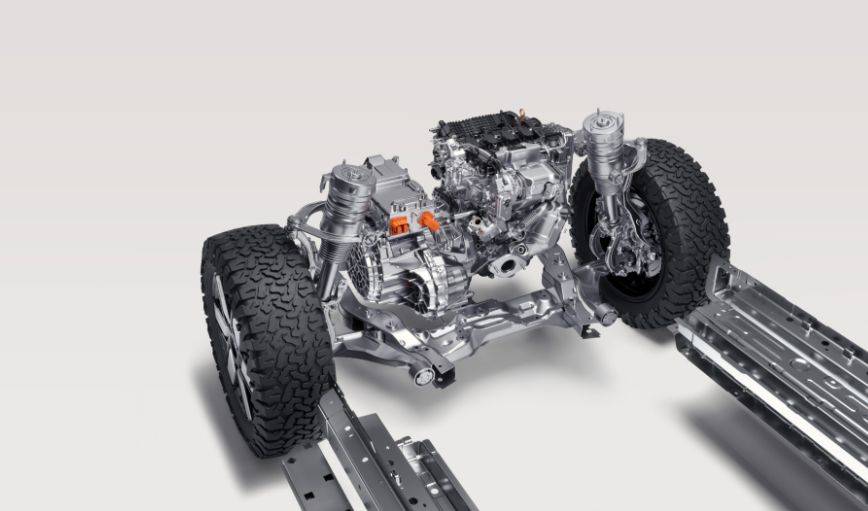The 2023 Guangzhou Auto Show will open on November 17th. At this important node, new energy vehicles are still the leading role of the halo, and China brands and foreign brands will all appear with heavy lineups. Then let’s take a sneak peek and see which new car can become the king of popularity.
New energy cars get together and appear.
1. Wuling starlight
The pre-sale of Wuling Guanxuan Starlight Hybrid Car will be started at Guangzhou Auto Show. This is the first B-class car of Wuling Yinbiao series, and it is also the first attempt of Wuling to March into high-end products. It is estimated that the pre-sale price will be around 120,000 yuan, and the main selling point is still strong cost performance.

Wuling Starlight is based on Wuling’s brand-new original new energy architecture, which will provide pure electricity and plug-in hybrid power. It will be equipped with Wuling Shenlian battery and Wuling Lingxi hybrid system. The brand-new architecture enables the whole vehicle to be lightweight, with wind resistance of 0.228cd and 1.5L engine, maximum power of 78kW, maximum thermal efficiency of 43.2%, comprehensive fuel consumption of WLTC standard as low as 3.98L/100km and NEDC standard fuel consumption as low as 3.77.

The pure electric vehicle is equipped with Zhuhai INBOR electric motor with a maximum power of 100kW and a maximum speed of 150km/h, and is equipped with lithium iron phosphate battery. It is understood that the energy density of "Shen Lian Battery" is more than 165Wh/kg, the peak power is more than 300kW, and the charging and discharging efficiency is more than 96%.

2. Qi Rui Xing Tu Xing Ji ES
Xing Jiyuan ES, the first high-end pure electric car under the Xingtu brand of Chery Automobile, will be pre-sold at Guangzhou Auto Show, and the official blind order price is 260,000-360,000 yuan.

The new car is positioned as a medium-sized and large-sized pure electric car, which was born on E0X high-performance platform and has the characteristics of long battery life and fast charging. The power consumption of CLTC is as low as 11.7kWh per 100 kilometers, the battery life can be 150 kilometers after charging for 5 minutes, the energy can be replenished by 30% to 80% in 15 minutes, and the long comprehensive battery life can reach 720 kilometers.

Xingyue ES adopts double wishbone front suspension and five-link rear suspension design, and the high-equipped models are also equipped with intelligent air suspension +CDC electromagnetic damping system, as well as all-aluminum chassis, integrated die-casting and 6-piston all-aluminum calipers. The handling performance is worth looking forward to. The new car will provide pure electric rear-drive versions of 185kW and 230kW, and front and rear dual-motor four-wheel drive versions of 123kW and 230kW, which can achieve 3-second acceleration.

Thanks to E0X high-performance electric platform, the 70.2% net space occupancy rate of Xingjiyuan ES is the best in its class, with a large body of nearly 5 meters, a long wheelbase of 3 meters and a five-seat layout, which effectively broadens the comfortable driving space.

In addition, the new car also has intelligent driving assistance. The Star Way Star Era ES, the first model of iFLYTEK Spark Cognition, can be called the first batch of mass production vehicles in the world to get on the real big model. Its intelligent driving has a super computing platform of 512TOPS, supplemented by hardware with higher perception, bringing a more worry-free, labor-saving and time-saving driving experience.
3. Intellectual S7
Huawei’s smart car selection business has joined Chery Automobile, a new partner, and the smart car Zhijie S7 jointly built has started the pre-sale. The new car has pushed four models, with a pre-sale price of 258,000 yuan. The new car will be produced on a brand-new platform based on Huawei’s full-stack smart car solution under the strong alliance of Huawei and Chery.

The intelligent world S7 adopts the same brand-new family design as the intelligent world M9, and the OneBox has a futuristic shape, without the traditional front cabin, and the interior space is more spacious. The panoramic canopy adopts double-layer silver-plated heat insulation technology, the window adopts double-layer sound insulation glass, and the borderless door is more high-end.

The new car is equipped with Huawei Turing intelligent chassis, and its handling performance is more stable. The new Huawei "Whale" 800V high-voltage battery platform and the thinnest battery pack in the industry make CLTC’s comprehensive battery life as high as 800+km. With Huawei’s 800V high-voltage overcharge platform, it can be charged for 15 minutes, and its battery life is 400+km, so you can get a calm pure electric travel experience regardless of city commuting or high-speed long distance.

The wisdom of Zhijie S7 goes further, starting parking on behalf of the driver, parking independently, on call; HarmonyOS4 HarmonyOS Intelligent Cockpit and HUAWEIADS2.0 Advanced Intelligent Driver Assistance System will bring car users a new experience of full-scene intelligent travel.


The differentiation advantage of this car lies in the innovation of some daily use experiences, such as the transparent view of yacht driving cabin; The zero gravity seat co-driver is equipped with a silk cloud seat, which brings a more comfortable driving experience. The center console in the position of the Queen’s co-pilot can be used as a dresser when parking, and can also be put into a notebook for office. There are two 50W mobile phone wireless fast chargers and three 66W wired fast chargers in the front row, and the armrest box in the front row is provided with a hidden cooling and heating box.
4. Geely Galaxy E8
The Galaxy E8, the first high-end pure electric vehicle built by Geely Galaxy based on the vast architecture of SEA, will be pre-sold at Guangzhou Auto Show and is expected to be listed in the fourth quarter of this year.

Geely Yinhe E8 adopts a brand-new design language of "ripple aesthetics", and the front face is integrated with modern scientific and technological elements, inheriting and evolving the front face of water ripple in Geely fuel vehicle era, adding elements such as sound, light, electricity, people, cars and the internet, and the lights are as sparkling as ripples in the West Lake. The design of the cornice headlight group, the rising sun penetrating taillights, and the body profile of Runyu streamer integrates culture, technology and experience, making the appearance of Geely Yinhe E8 scientific and elegant, sporty and elegant, and achieving the perfect balance between ergonomics and design aesthetics. In addition, the new car adopts low wind resistance design such as closed pneumatic rim, and the wind resistance coefficient is only 0.199Cd.

Geely Galaxy E8 extends the cosmology of "harmony between man and nature" in Chinese culture to the cockpit space of science and technology. The effective display area of 45-inch 8K screen reaches 1130mm*138mm, and a 7.5mm frame is realized, with a screen ratio of 98% and a thickness of 9.8mm. The pixel of the screen is 7680×936, reaching the quasi-retinal level 8K pixels per inch. When the vehicle is in the P-gear state, this big screen also supports the direct connection of mobile phones or handles to play games. In addition, Geely Yinhe E8 will also be equipped with a new generation of Qualcomm Snapdragon 8295 flagship cockpit chip and a brand-new vehicle system. With 5nm process, the AI computing power will reach 30TOPS, which is 2 times higher than that of 8155(7nm)GPU and 3 times higher than that of 3D rendering.

At present, the official has not released the relevant information of the three-electric system of this car. From the declared information, the rear-drive version will be driven by a permanent magnet synchronous motor with a maximum power of 200kW.
5. Extreme Krypton 007
Krypton will launch a brand-new high-end pure electric car Krypton 007 at Guangzhou Auto Show, and start the pre-sale.

Based on PMA2+ platform, Krypton 007 is positioned as a medium-sized pure electric car. The whole car adopts a brand-new design, especially the intelligent headlights with three layers of lights. The visual effect is cool, the front face lines are simple, and the front cover is raised on both sides. Officially, it is called "HiddenEnergy" minimalist luxury aesthetic design.

It is worth mentioning that Krypton 007 will be the first to apply the ZEEKRSTARGATE integrated intelligent light curtain with the world’s largest 90-inch ultra-wide display area, which supports custom light language settings and brings a full sense of ceremony whether parking or driving. In addition, in terms of driving assistance, the official revealed that the car can have up to three laser radars, with a wealth of sensing elements and Snapdragon 8295 chips, which is not expected to disappoint users in terms of advanced driving assistance.

The new car is also expected to be equipped with a double wishbone front independent suspension, equipped with a motor with a maximum power of 204 HP, with a peak torque of 350 Nm and an acceleration of 0-100 km/h in only 6.5 seconds. In addition, the vehicle also uses an 800V electrical architecture, which can fully charge the battery in 30 minutes.
6. Red Flag EH7
Hongqi E001, which debuted at Shanghai Auto Show, will be unveiled at Guangzhou Auto Show in the name of EH7. The new car is built on the platform architecture of Hongqi FMSs, with a maximum cruising range of 800km, and is expected to be launched this year.

According to the application information, Hongqi EH7 is positioned as a medium-sized and large-sized pure electric car with a body size of 4980/1915/1490mm, a wheelbase of 3000mm and a curb weight of about 2.3 tons. Hongqi EH7 is available in single-motor and dual-motor versions. The peak power of single-motor version is 253kW, and that of dual-motor version is 455kW. In terms of battery life, Hongqi EH7 is equipped with Contemporary Amperex Technology Co., Limited ternary lithium battery, and the battery-changing version has a battery life of 600 kilometers, which can be replaced within 60 seconds, and the battery can be upgraded later; The long battery life and fast charging version can reach 800 kilometers.
7, the new BMW i5
At the Guangzhou Auto Show, the new pure electric BMW i5 will make its debut. According to the plan, the new car will be put into production in January next year.

The new BMW i5 follows the design of the new BMW 5 Series as a whole. Different from the current models, the new car has a sharper line design, which outlines a more vivid sense of edges and corners. The "5" bright logo at the corner of Huo’s corner can produce blue breathing effect when the vehicle is charged, which is an exclusive customized design element for domestic users.

The new car is equipped with a 12.3-inch LCD instrument and a 14.9-inch touch screen. It is also equipped with an encircling interactive light belt, a hidden air conditioning outlet, and a suspended giant screen in the rear row. The screen size reaches 31 inches, the resolution is 8K, and it supports real-time interconnection. Not only that, the new car will also be equipped with Bowers & Wilkins surround sound system, four-zone automatic independent air conditioning (with independent control panel in the back row) and other high-end configurations.

The new BMW i5 adopts the upgraded fifth-generation eDrive electric drive system, providing both eDrive 40 and M60 xDrive. The entry-level model will be equipped with a rear motor, with a maximum power of 340 HP, a peak torque of 430 Nm, an acceleration time of 6.0 seconds from 0-100km/h and a top speed of 193 km/h.. As a version of M Performance, the M60 xDrive is equipped with stronger dual motors, sharing the powertrain with iX M60, with a maximum power of 601 HP and a peak torque of 820 Nm. It is officially announced that its 0-100km/h acceleration time is 3.8 seconds, and its top speed is limited to 230 km/h. Future domestic models may be eDrive40L and xDrive40L l.
New energy SUV is still the focus
1. BYD Sea Lion 07 EV
BYD’s brand-new model Sea Lion 07 EV will make its debut at Guangzhou Auto Show. The overall design of the new car is fashionable, avant-garde, elegant and stylish, with the extraordinary temperament and vigorous posture of the lion king in the sea.

BYD Sea Lion 07 is positioned in a medium-sized SUV, specifically a coupe SUV. The front face continues the design of Ocean X concept car, and the front hatch cover has two raised ribs, showing full speed and explosive force, and deducing the vigorous form of "the lion king in the sea". Large-size wide-body wheel eyebrows are matched with five sharp wheels to better balance the proportion of the car body. The penetrating taillights at the top of the rear are very similar to seals.

The newly designed Sea Lion 07EV is an advanced work of E platform 3.0, and the relevant parameters such as vehicle configuration have not been announced yet.
2. BYD Song L.
The pre-sale price of BYD Song L is 220,000-280,000 yuan, which will be officially listed at the Guangzhou Auto Show. The official positioning of the B-class pioneer hunting SUV has launched five models.

The appearance of Song L adopts the more fashionable and young pioneer Longyan aesthetic design, and the electric tail and frameless door show personality in the details. The big five-seat space has a long wheelbase of 2930mm and is equipped with an integrated sports seat, which has many comfortable functions such as ventilation, heating, massage and leg rest.
Song L adopts the power combination architecture of front induction asynchronous motor and rear permanent magnet synchronous motor. The maximum output power of the system is 380kW, the peak torque is 670N·m, and the acceleration is 4.3 seconds. The self-developed four-piston aluminum alloy fixed clamp has fast braking response, and the braking distance is within 36 meters per 100 kilometers.

Song L comes standard with front double wishbone and rear five-link chassis suspension, which has strong roll control and good grip ability. The intelligent damping body control system Yunqi -C realizes the perfect compatibility of vehicle comfort and handling. E platform 3.0 adopts CTB battery body integration technology, and the torsional stiffness of the car body reaches 40,400 N m/,the torsional deformation of the car body is smaller, and the response of the car body is faster, which is comparable to that of a million luxury SUV;. The configuration of narrow front and wide rear tires and iTAC intelligent torque distribution system together help Song L improve the upper limit of handling.

DiLink intelligent cockpit, DiPilot intelligent driver assistance system and intelligent entry together constitute the three intelligent systems of Song L. At the same time, Song L cooperated with many ecological partners, such as Gaode Map, Dana Audio, Himalayan, Netease Cloud Music, etc., to create a rich car scene. DiPilot intelligent driver assistance system not only provides active safety, but also brings automatic parking and remote parking functions; DiLink intelligent cockpit adopts 6 nm process chip and integrates 5G baseband technology; DiLink intelligent network system is 100% compatible with Android ecosystem, and the response time of intelligent voice wake-up in the whole scene is as fast as 400 milliseconds.
3. Tank 700Hi4-T first limited edition
At this Guangzhou Auto Show, the first limited edition of the tank 700Hi4-T of Great Wall Motor Tank brand will complete its debut and start the pre-sale. The pre-sale price is expected to start at 700,000 yuan.

The first limited edition of Tank 700Hi4-T is a luxury off-road SUV built on the Hi4-T off-road super hybrid architecture, which integrates top performance, advanced technology, luxurious interior and extraordinary quality.
The front face of the new car adopts simple horizontal line design, the center is the tank brand LOGO, and the circular headlights on both sides have personalized LED light groups inside. The side lines are complex and the waistline is changeable, creating a strong sense of hierarchy. The overall shape is cool, and the wheel hub, wheel eyebrow and front face are all upgraded. In addition to the golden sports wheel hub, the wheel eyebrows of the car body have also been widened, with a new style of front and rear bars and a new front spoiler and sports tail installed.

The tank 700Hi4-T will be equipped with a hybrid system consisting of a 3.0T engine and a motor, with a comprehensive power of 265kW, matching with a 9AT gearbox, and both oil and electricity can be directly driven, with an acceleration of 100 kilometers or up to 5 seconds.

The first edition of tank 700 Hi4-T is equipped with air suspension. In the standard state, the approach angle is 22, the departure angle is 26, and the longitudinal passing angle is 22.5. When the suspension is raised, the approach angle can be raised to 27.8, the departure angle is 32.4, and the longitudinal passing angle is 28, which further improves the vehicle’s passing ability and off-road ability.
4, ask M9
AITO M9, known as the "King of High-tech Cars" in Yu Chengdong, will appear at the Guangzhou Auto Show. At present, the pre-sale order for new cars has exceeded 25,000, and the car will be listed in December, with an estimated price of 500,000-600,000 yuan.

According to the official, the design of the M9 in the world revolves around "people" and serves the function on the basis of aesthetics. Use the inside-out design to make the form follow the function and highlight the people-oriented concept.

As a full-size flagship SUV, Wenjie M9 has a length of 5230mm and a wheelbase of 3110mm, and has a comfortable space comparable to MPV. Three rows have no steps to facilitate entry and exit, and the second row has a wider adjustable range from front to back. All the seats in the car are provided with electric slide rails and a 3-6-seat changeable seat mode. The newly-built D-class luxury SUV platform is equipped with an all-aluminum chassis, and the whole system comes standard with air springs and CDC damping system. Huawei’s smart car full-stack technology solutions are also fully on board. On the basis of the smart cockpit and intelligent driving double "ceilings", black technologies such as megapixel smart headlights, HUAWEI AR-HUD, AI big model and sensing federation are all on board, bringing a full-scene intelligent experience.

In terms of power, Wenjie M9 plans to launch two models: extended range and pure electric. The pure electric version will be equipped with dual motors with maximum power of 160kW and 230kW respectively. The extended range version is also equipped with dual motors, with maximum power of 165kW and 200kW respectively, and a 1.5T engine with maximum power of 112kW. In addition, the new car is also equipped with rear wheel follow-up steering, digital headlights, 800V fast charging, independent entertainment screen of the co-pilot, rear light field screen, and queen seat of the co-pilot.
5. Chevrolet Explorer EV
Recently, SAIC-GM announced the lineup of the 2023 Guangzhou Auto Show, and the new pure electric SUV Chevrolet Explorer EV will make its debut.

Chevrolet Explorer EV is built on the platform of General Motors Autoenergy, with an avant-garde and fashionable appearance, and the wheelbase is increased to 2954mm, which is completely different from the fuel version Explorer. The design of the new car does not adopt the style of the domestic explorer fuel version, but is consistent with the overseas version.

According to the application information, this medium and large SUV is the performance version of Explorer EV RS, with a sports kit. The power is four-wheel drive with front and rear dual motors, and the maximum power is 143kW and 68kW respectively. It matches the era of SAIC ternary lithium battery, and the battery capacity is expected to be 80kWh. The cruising range is about 600km.
The last egg
Ideality MEGA
LI announced that the ideal MEGA pure electric MPV will be unveiled at the Guangzhou Auto Show and will be pre-sold. The new car is expected to be listed in December, arrive in the store in January next year and start delivery in February.

As LI’s first pure electric vehicle, Ideal MEGA has a design style similar to bullet train, which effectively reduces the drag coefficient. The front of the car is closed, with square headlights on both sides and LED light source inside. The side shape of the car body is also relatively novel, with short front and rear suspension design. The front and second rows of sideslip door handles are hidden, the tail design is as simple as the front face, and the penetrating taillights echo the front.

The ideal MEGA will be equipped with 5C Kirin battery, which can increase the battery life by 500 kilometers after 12 minutes of charging, and the power consumption under CLTC condition is 15.9kWh/100km.
At present, LI is stepping up the construction of supporting 5C super charging stations, and plans to land 300 5C super charging stations by the end of 2023, so as to realize the full coverage of 10 national highways, covering 70% of the national highway mileage in the four major economic belts. (Text: Yang Xiaohong Figure: Enterprise)



























































































